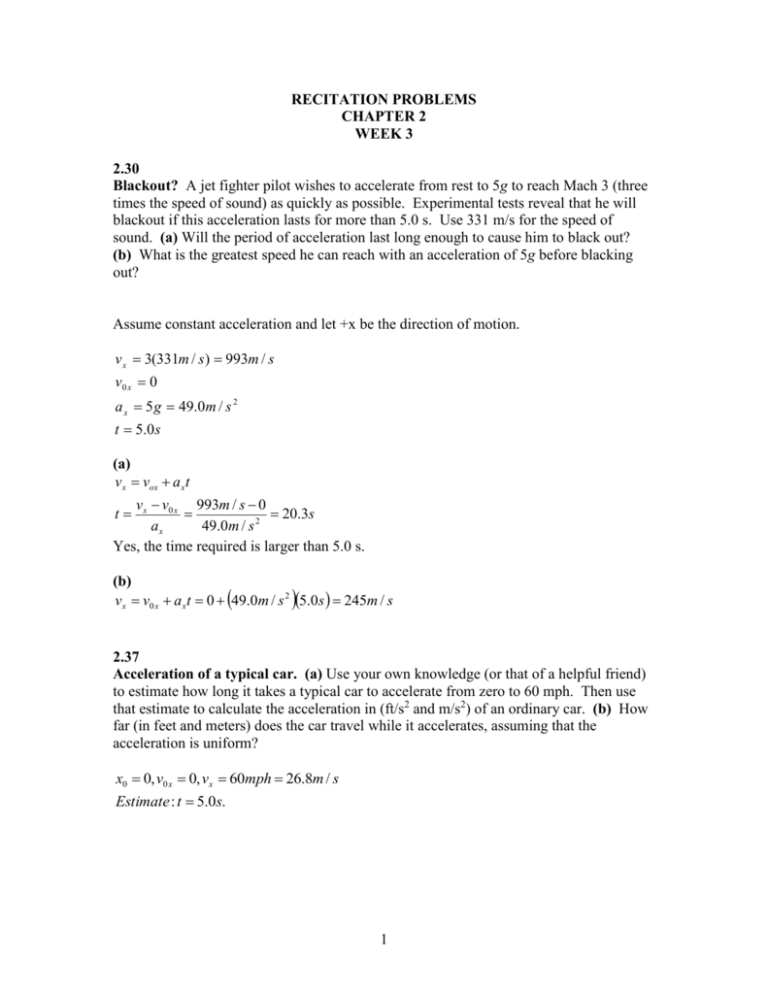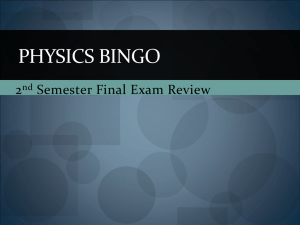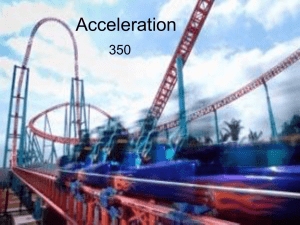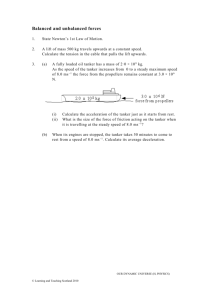Solutions_ch2
advertisement

RECITATION PROBLEMS CHAPTER 2 WEEK 3 2.30 Blackout? A jet fighter pilot wishes to accelerate from rest to 5g to reach Mach 3 (three times the speed of sound) as quickly as possible. Experimental tests reveal that he will blackout if this acceleration lasts for more than 5.0 s. Use 331 m/s for the speed of sound. (a) Will the period of acceleration last long enough to cause him to black out? (b) What is the greatest speed he can reach with an acceleration of 5g before blacking out? Assume constant acceleration and let +x be the direction of motion. v x 3(331m / s ) 993m / s v0 x 0 a x 5 g 49.0m / s 2 t 5 .0 s (a) v x vox a x t v x v0 x 993m / s 0 20.3s ax 49.0m / s 2 Yes, the time required is larger than 5.0 s. t (b) v x v0 x a x t 0 49.0m / s 2 5.0s 245m / s 2.37 Acceleration of a typical car. (a) Use your own knowledge (or that of a helpful friend) to estimate how long it takes a typical car to accelerate from zero to 60 mph. Then use that estimate to calculate the acceleration in (ft/s2 and m/s2) of an ordinary car. (b) How far (in feet and meters) does the car travel while it accelerates, assuming that the acceleration is uniform? x0 0, v0 x 0, vx 60mph 26.8m / s Estimate : t 5.0s. 1 (a) vx v0 x axt ax vx v0 x 26.8m / s 0 5.4m / s 2 18 ft / s 2 t 5.0s (b) 1 1 2 x x0 v0 x t a x t 2 5.4m / s 2 5.0s 68m 220 ft 2 2 2.45 Two rockets having the same acceleration start from rest, but rocket A travels for twice as much time as rocket B. (a) If rocket A goes a distance of 250 km, how far will rocket B go? (b) If rocket A reaches a speed of 350 m/s, what speed will rocket B reach? Set Up: a A aB , x0 A x0 B 0, v0 x , A v0 x , B 0, t A 2t B (a) 1 1 1 2 2 x x0 v0 x t a x t 2 gives x A a At A and xB aB t B . 2 2 2 x x a A a B gives A2 B2 and tA tB 2 t 1 x B B x A 250km 62.5km 2 tA 2 (b) v x v0 x a x t gives a A Since a A a B , vA v and a B B . tA tB v A vB and t A tB t 1 v B B v B 350m / s 175m / s 2 tA 2 2.54 On Planet X, you drop a 25 kg stone from rest and measure its speed at various times. Then you use the data you obtained to construct a graph of its speed v as a function of time t. From the information in the graph, answer the following questions: (a) What is g on Planet X? (b) An astronaut drops a piece of equipment from rest out of the landing module, 3.5 m above the surface of Planet X. How long will it take this equipment to reach the ground, and how fast will it be moving when it gets there? (c) How fast would an astronaut have to project an object straight upward to reach a height of 18.0 m above the release point, and how long would it take to reach that height? Take +y to be downward. The acceleration is the slope of v y versus t graph. (a) Since v y is downward, it is positive and equal to the speed v . The v y versus t graph has slope a y 30.0m / s 15m / s 2 . 2.0 s (b) v 0 y 0 and let y0 0. y y 0 v0 y t 1 a y t 2 gives t 2 2y 23.5m 0.68s ay 15m / s 2 v y v0 y a y t 15m / s 2 0.68s 10.2m / s (c) At the maximum height, v y 0. Let y0 0 . v y2 v02y 2a y y y0 gives v0 y 2a y y y 0 2 15m / s 2 18.0m 23m / s. v y v0 y a y t gives t v y v0 y ay 1.5s 3 The acceleration is 9.81 m/s2, downward. The velocity initially is upward, decreasing to zero because of the downward acceleration and then is downward and increasing in magnitude because of the downward acceleration. 2.74 Testing reaction time. A meter stick is held vertically above your hand, with the lower end between your thumb and first finger. On seeing the meter stick released, you grab it with those two fingers. You can calculate your reaction time from the distance the meter stick falls, read directly from the point where your fingers grabbed it. (a) Derive a relationship for your reaction time in terms of this measured distance d. (b) If the measured distance is 17.6 cm, what is the reaction time? Let +y be downward. The meter stick has initial velocity v 0 y 0 and a y 9.80m / s 2 . The time the meterstick falls is your reaction time. Let d be the distance the meterstick falls. 1 d (a) y y 0 v0 y t a y t 2 gives d 4.90m / s 2 t 2 and t . 2 4.90m / s 2 0.176m (b) t 0.190s. 4.90m / s 2 2.76 A 0.525 kg ball starts from rest and rolls down a hill with uniform acceleration, traveling 150 m during the second 10.0 s of motion. How far did it roll during the first 5.0 s of motion? Let +x be in the direction down the incline. The final velocity for the first 10.0 s is the initial speed for the second 10.0 s of the motion. For the first 10.0 s of motion v0 x 0 and v x a x 10.0s . For the second 10.0 s of motion, v0 x a x 10.0s , x x0 150m and t =10.0 s. 1 1 2 2 x x0 v0 x t a x t 2 gives 150m 10.0s a x a x 10.0m / s 150.0a x and 2 2 2 a x 1.0m / s . Then for the first 5.0 s, 1 1 2 x x0 v0 x t a x t 2 0 1.00m / s 2 5.0s 12.5m. 2 2 4








